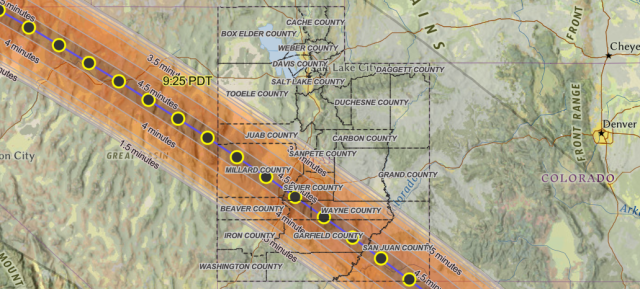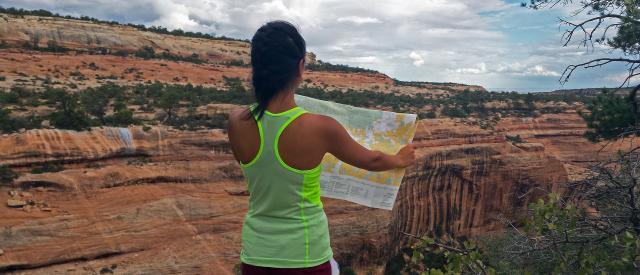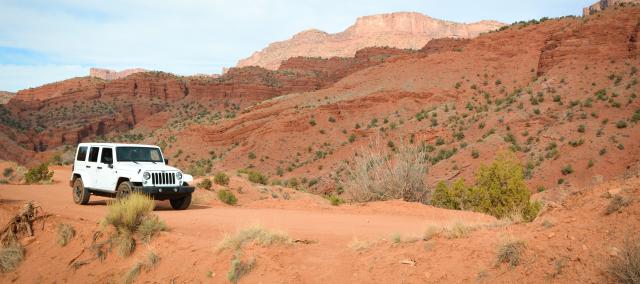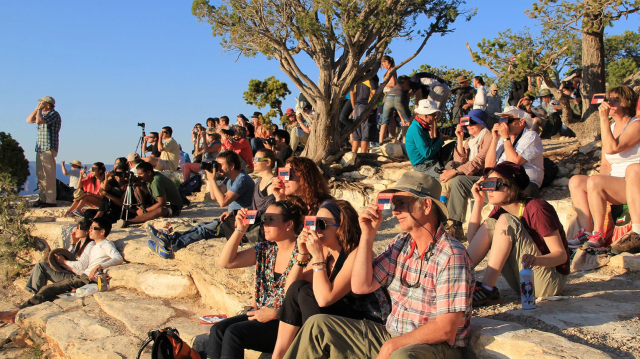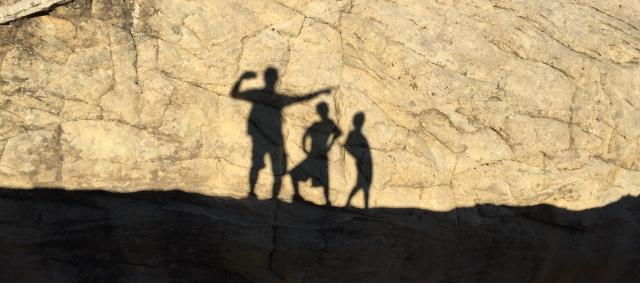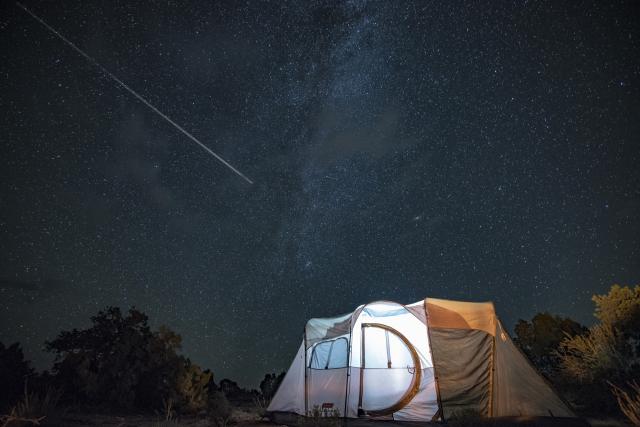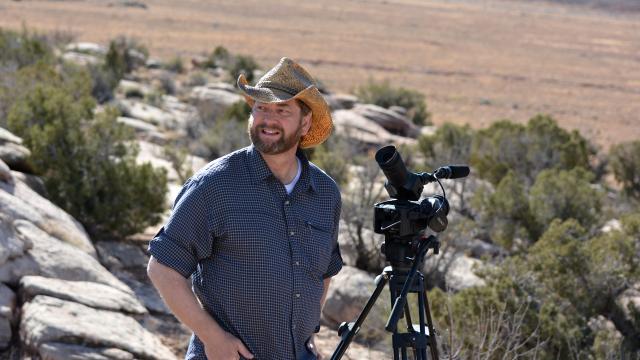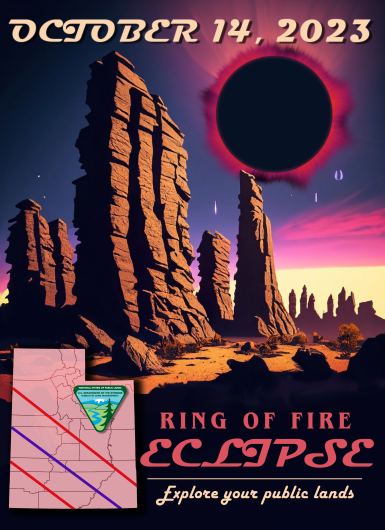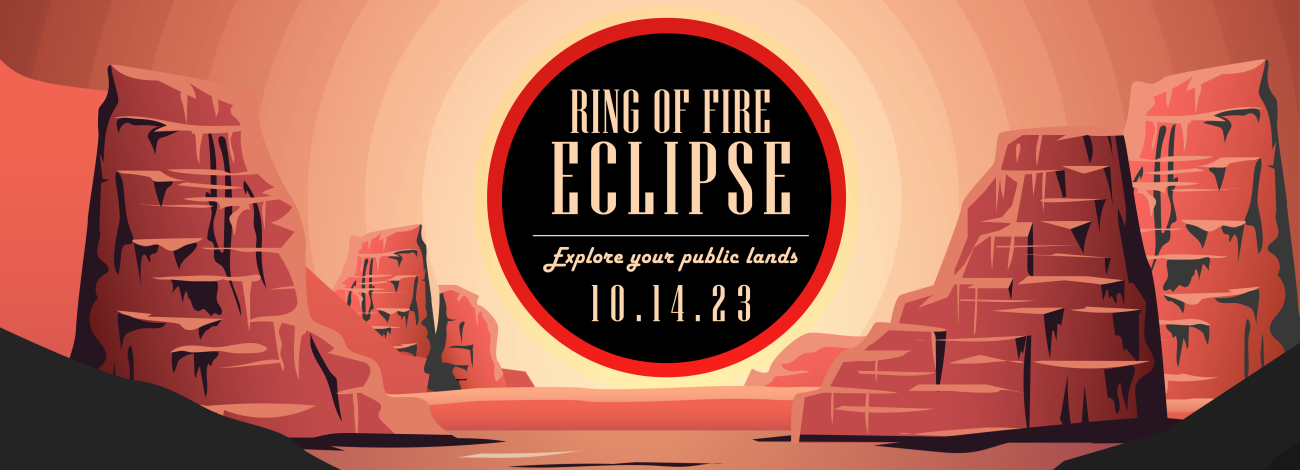
2023 Solar Eclipse in Utah
Annular solar eclipse: Oct. 14, 2023
On Saturday, Oct. 14, 2023, an exceptional annular solar eclipse will cross several continents -- including BLM-managed lands, resources, and facilities in Utah. Public lands offer wonderful opportunities for safe eclipse viewing! Review the information below to learn about preparing for your visit, safely viewing the eclipse, and more.
Prepare for your visit
If you intend to watch the eclipse on public lands, come prepared! Have plans for when and where you're going, make sure to bring everything you need, and be flexible on the day of the eclipse.
- WHERE TO GO
-
Visit the BLM Utah Interactive Eclipse Map to determine where you can make the most of your eclipse experience. The eclipse will cross every BLM district in Utah, with optimal locations in West Desert, Color Country, Paria River, and Canyon Country districts. Visit the BLM Utah Interactive Eclipse Map to browse BLM lands and determine which district would provide the best viewing for your trip. For views of the eclipse, choose a location with fewer trees or large landscape features. Avoid canyons and opt for a spot with expansive upward views.
- WHAT TO BRING
-
BLM Photo by Hannah Cowan. Many BLM lands in Utah are remote with minimal access to services and goods. Make sure you have plenty of gas in your car. Check that you have everything with you before departing on your trip and consider bringing:
- Food and water
- Comfortable shoes, a hat, sunscreen, and other weather-appropriate gear (check the forecast)
- Eclipse glasses, eclipse viewers or a camera fitted with a solar filter
- Map of the area you're visiting (cell service can be unreliable)
- A bag for your trash (must be packed out)
- WHEN TO ARRIVE
-
The timing of the eclipse will vary throughout the state. A partial eclipse will be visible in the state of Utah sometime from 9:07 a.m. to 12:01 p.m. (Mountain Time). Annularity -- the time at which the "ring of fire" appears around the moon -- is estimated to be visible in the range of 10:24 a.m. to 10:35 a.m. (Mountain Time), lasting up to 4 minutes 40 seconds in some parts of Utah. Find guidance on timing for specific locations see our community partner's website. Don't forget to set your clocks to Mountain Time if you're visiting from another time zone!
Whenever you are planning to arrive, consider coming early and staying late. BLM Utah lands are normally remote, but with so many visitors coming to see the eclipse, it is possible that there will be extreme traffic delays. Factor traffic into your plans for the eclipse.
- WHAT TO EXPECT
-
Viewing the eclipse can be affected by many factors like weather, fire, location, and visitation:
- Rain, clouds, fog, and smoke from wildfires can all obscure views of the eclipse. Stay up to date on weather conditions, check for nearby wildfires on utahfireinfo.gov, and practice fire safety during your visit.
- The location you choose will also play a role in your experience. For best views of the eclipse, choose a location with fewer trees or large landscape features. Avoid canyons and opt for a spot with expansive upward views.
- Note that restrooms are not widely available on BLM-managed lands. Use the bathroom before you arrive and know how to properly do your business outside.
- BLM-managed lands are often used by local ranchers for grazing cattle. Camp at least 300 feet from range improvements. Range improvements can include corrals, gates, livestock waters and livestock pens. See our Dispersed Camping Handout for more information.
- Other visitors enjoying the eclipse can also affect your experience. Do your best to treat all other visitors with kindness and patience.
Follow BLM Utah on all social media (Facebook, Instagram, Twitter) for day-of updates on eclipse happenings throughout the state.
- TRAFFIC AND ROAD CONDITIONS
-
BLM Photo by Ryan Sutherland. BLM Utah expects the eclipse to attract millions of visitors to public lands, many of whom may be unfamiliar with land management boundaries, roads, facilities, and other details that may influence their experience. Remember that these public lands are normally remote, but with so many visitors coming to see the eclipse, it is possible that there will be extreme traffic delays. Factor traffic into your plans for the eclipse and be prepared to arrive early and/or stay late.
Be aware that road conditions vary greatly throughout BLM lands in Utah, including everything from paved highways to unmaintained two-track roads. Not every vehicle will be suited to every road. Road conditions can change with the weather and some routes are hazardous in wet conditions. Check weather forecasts in remote areas by visiting weather.com. Contact the BLM District Office managing the location of your eclipse trip for road conditions (West Desert District, Green River District, Color Country District, Paria River District, Canyon Country District).
BLM-managed lands are often used by local ranchers for grazing cattle. Be sure to leave gates however you find them, whether open or closed.
During the eclipse
In addition to viewing the eclipse in a responsible way, make sure to respect the landscape and other visitors during your trip. Review the tips below to have a safe, respectful and responsible experience on public lands during the eclipse.
- VIEW THE ECLIPSE SAFELY
-
National Park Service photo. It is never safe to look directly at the sun, especially during an eclipse. To safely view the eclipse, review NASA's safety guidance and consider one of the following methods:
- Use eclipse glasses or an eclipse viewer. These tools use dark filters and comply with international standards to keep your eyes safe from the sun. Sunglasses, no matter how dark their lenses, do not provide the same protection as eclipse glasses or viewers.
- View the eclipse through a camera or binoculars fitted with solar filters: Make sure that the solar filter you're using has been checked by a professional who can verify its reliability. Do not look through a camera lens or binoculars unless they have a solar filter. The lens will concentrate the rays of the sun and can damage your eyes even if you are wearing eclipse glasses.
- Use an indirect viewing method: During an eclipse, you can project an image of the sun onto surfaces by filtering the sun's rays through a small opening. Methods for indirect viewing range from using your hands to creating a pinhole projector with a cereal box.
- LEAVE NO TRACE
-
Whenever you visit public lands, it is always important to Leave No Trace. Although the eclipse will last a few minutes at most, your visit could impact public lands for years. Know the Seven Principles of Leave No Trace and how they apply to the eclipse:
- Plan ahead and prepare: If you're looking through this webpage, you can check this one off! Know before you go by reviewing the resources on this page, checking weather conditions, and making sure you have everything you need with you before your trip.
- Travel and camp on durable surfaces: While visiting public lands during the eclipse, make sure you are driving and hiking on durable surfaces only. Do not drive or walk on vegetation.
- Dispose of waste properly: There are not many places on BLM lands to dispose of trash or waste. The expectation is that you will pack your waste out and dispose of it when you reach a location that accepts trash. Note that restrooms are not widely available on BLM lands. Use the bathroom before you arrive and know how to properly do your business outside. Please remember that pit toilets are not dumpsters, and neither is nature.
- Leave what you find: Leave plants, archaeological artifacts, and other objects of interest as you find them; instead of taking home a piece of the landscape, hang onto your eclipse glasses as a memento of your experience!
- Minimize campfire impacts: The only ring of fire you want to see during the eclipse is the one in the sky! You can prevent wildfires by building fires only in existing fire rings or fire pans, drowning your campfire before leaving it or going to sleep, and parking your vehicle away from dry vegetation. Check utahfireinfo.gov for fire restrictions before making a fire.
- Respect wildlife: Wildlife sometimes acts strangely during an eclipse: thinking it's nighttime, birds stop singing and mammals retreat to their homes for sleep. If you happen to encounter wildlife during an eclipse (lucky you!), make sure to give it space.
- Be considerate of others: There's no need for a total eclipse of the heart. Everyone experiences the eclipse differently. Be respectful of others' experiences by keeping your volume low and providing space when you can.
- RESPECT OTHERS
-
BLM Photo by David Christensen. Everyone coming out to see the eclipse wants to have a good experience. Be respectful of those nearby during the event. Keep in mind that many of the local towns surrounding BLM lands in the eclipse's path are small communities with limited resources. Follow local rules, ordinances, and traffic patterns. Be patient with rangers, volunteers and local community members.
Not everyone will experience the eclipse in the same way. Many Indigenous cultures do not view eclipses according to their cultural teachings. As a result, Tribal lands and Tribal parks may be closed during the eclipse. Learn about Navajo and Cherokee eclipse teachings. People who are blind or visually impaired may experience this celestial event by listening to eclipse soundscapes or reading about the eclipse in Braille.
After the event
Your experience on public land doesn't have to end when the eclipse does! If you decide to camp on BLM lands on the weekend of the eclipse, make sure you know the rules and regulations for doing so. Don't forget to share your photos and stories of the eclipse with the BLM on social media!
- CAMPING ON BLM LANDS
-
Photo by Chad Douglas. Like you, many other people are planning to visit BLM lands in Utah to observe the eclipse! As a result, most campgrounds and hotels throughout the state are booked. You might consider dispersed camping on BLM lands as an alternative. Remember that dispersed camping is not allowed everywhere and that the best campsites are found, not made. Be sure to Leave No Trace and get familiar with our rules and regulations before setting up your tent.
- SHARE YOUR PHOTOS AND EXPERIENCES
-
Photo by Chad Douglas. For a chance to be featured on blm.gov and BLM social media, let us know what your eclipse experience was like! Where did you choose to watch the eclipse? Who joined you? What did you find meaningful about the experience? Share your stories, photos, and videos with us on social media at Facebook, Instagram, and Twitter.
- PLAN FOR THE NEXT ECLIPSE
-
If you enjoy the 2023 Annular Solar Eclipse, hang on to your eclipse glasses! A total eclipse is scheduled to pass over North America in April 2024. The path of the 2024 Total Solar Eclipse will pass over the eastern half of the country. Just like the 2023 Annular Solar Eclipse, it'll be an event worth planning for!
Resources
Find online resources about the eclipse in the tabs below. Many of these resources are also available as quick links in the sidebar of this page!
- LOGISTICS AND CURRENT CONDITIONS
-
To learn more about the timing, duration, and location of the eclipse, visit the "Where & When" section of NASA's 2023 Annular Eclipse webpage. There, you can also find resources for safe eclipse viewing, frequently asked questions, and more.
For weather reports in remote BLM lands far from towns, visit weather.gov and use the map-click feature to select the area you're visiting. If you plan to camp on BLM-managed lands during your visit, check out our dispersed camping fact sheet.
The BLM Utah Interactive Map may be useful during your visit. Visit the Utah Department of Transportation website for information on traffic conditions.
- MEDIA AND PHOTO GALLERIES
-
See BLM's Dispersed Camping Fact Sheet for camping rules and regulations. BLM Utah will also be posting photos and videos taken by BLM staff on the day of the eclipse on social media (Facebook, Instagram, Twitter) and via Flickr.
NASA maintains a thorough gallery of diagrams, photos, and eclipse viewing resources on its Gallery | Resources page, notably including a map of the 2023 and 2024 eclipse paths over the United States. The Astronomical Applications Department of the Navy provides a wide variety of eclipse maps and calculations. The Rice Space Institute also maintains a page of eclipse animations for further learning.
- LEARNING ABOUT THE ECLIPSE
-
Diagram by the Rice Space Institute. An annular solar eclipse occurs when the moon passes in front of the Sun, but because the moon is in the part of its orbit furthest from Earth, the rays of the Sun can be seen outlining the moon. This positioning creates the "ring of fire" effect that annular solar eclipses are known for.
There are many wonderful educational resources about the upcoming annular eclipse online, including an overview and activity ideas from NASA as well as eclipse animations from the Rice Space Institute.

